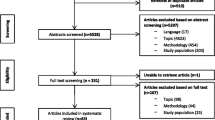Abstract
People with severe mental illnesses often require help not only with managing their illness, but with a broad array of social and domestic activities. The impacts of the presence of such needs in several domains of function on quality of life ratings in the same domains are assessed using data from a survey of Maryland Medicaid recipients who have severe and persistent mental disorders. Measures included self-report of need and whether help was received for it, and Lehman's Quality of Life Interview. The presence of need was associated with lower quality of life ratings, and met needs improved those ratings relative to unmet need. A current diagnosis of depression resulted in lower quality of life, but successful treatment raised scores significantly. These findings underscore the potential impact the mental health service system can have on the quality of the lives of people it serves.
Similar content being viewed by others
REFERENCES
Arns, P. G., & Liney, J. A. (1995). Relating functional skills of severely mentally ill clients to subjective and societal benefits. Psychiatric Services, 46, 260–265.
Atkinson, M., Zibin, S., & Chuang, H. (1997). Characterizing quality of life among patients with chronic mental illness: A critical examination of the self-report methodology. American Journal of Psychiatry, 154, 99–105.
Awad, A. G., Voruganti, L. H., & Heslegrave, R. G. (1997). A conceptual model of quality of life in schizophrenia: Description and preliminary clinical validation. Quality of Life Research, 6, 21–26.
Baker, F., & Douglas, C. (1990). Housing environments and community adjustment of severely mentally ill persons. Community Mental Health Journal, 26, 497–505.
Bellack, A. S., Morrison, R. L., Wixted, J. T., & Mueser, K. T. (1990). An analysis of social competence in schizophrenia. British Journal of Psychiatry, 156, 809–818.
Browne, S., Roe, M., Lane, A., Gervin, M., Morris, M., Kinsella, A., Larkin, C., & Callaghan, F. O. (1996). Quality of life in schizophrenia: Relationship to sociodemographic factors and tardive dyskinesia. Acta Psychiatrica Scandinavica 94, 118–124.
Koivumaa-Honkanen, H. T., Viinamäki, H., Honkanen, R., Tanskanen, A., Antikainen, R., Niskanen, L., Jääskeläinen, J., & Lehtonen, J. (1996). Correlates of life satisfaction among psychiatric patients. Acta Psychiatrica Scandinavica, 94, 372–378.
Lehman, A. F. (1983). The effects of psychiatric symptoms on quality of life assessments among the chronically mentally ill. Evaluation and Program Planning, 6, 1443–1451.
Lehman, A. F. (1988). A quality of life interview for the chronically mentally ill. Evaluation and Program Planning, 11, 51–62.
Lehman, A. F., Rachuba, L. T., & Postrado, L. T. (1995). Demographic influences on quality of life among persons with chronic mental illnesses. Evaluation and Program Planning, 18, 155–164.
Packer, S., Husted, J., Cohen, S., & Tomlinson, G. (1997). Psychopathology and quality of life in schizophrenia. Journal of Psychiatry and Neuroscience, 22, 231–234.
Patterson, T. L., Shaw, W., Semple, S. J., Moscona, S., Harris, M. J., Kaplan, R. M., Grant, I., & Jeste, D. V. (1997). Health-related quality of life in older patients with schizophrenia and other psychoses: Relationships among psychosocial and psychiatric factors. International Journal of Geriatric Psychiatry, 12, 452–461.
Shern, D. L., Wilson, N. Z., & Coen, A. S. (1994). Client Outcomes II: Longitudinal client data from the Colorado Treatment Outcome Study. The Milbank Quarterly, 72, 123–148.
Skantze, K., Malm, U., Dencker, S. J., May, P. R. A., & Corrigan, P. (1992). Comparison of quality of life with standard of living in schizophrenic out-patients. British Journal of Psychiatry, 161, 797–801.
Steinwachs, D. M., Fisher, E. P., & Lehman, A. F. (1996). Outcomes assessment: Information for improving mental health care. New Directions for Mental Health Services, 71, 49–57.
Steinwachs, D. M., Lehman, A. F., Fahey, M., Gaynor, M., & Wright, G. (1996). Utilization and cost of care for severely mentally ill persons on Medicaid: Development and validation of a classification system.
Author information
Authors and Affiliations
Corresponding author
Rights and permissions
About this article
Cite this article
Skinner, E.A., Steinwachs, D.M., Handley, K. et al. Met and Unmet Needs for Assistance and Quality of Life for People with Severe and Persistent Mental Disorders. Ment Health Serv Res 1, 109–118 (1999). https://doi.org/10.1023/A:1022594320569
Issue Date:
DOI: https://doi.org/10.1023/A:1022594320569




